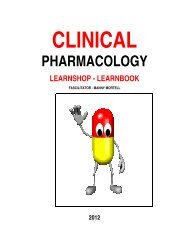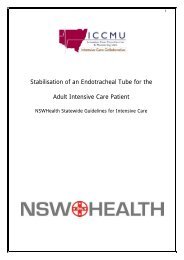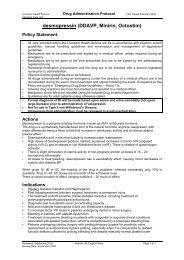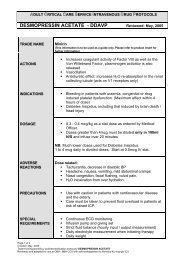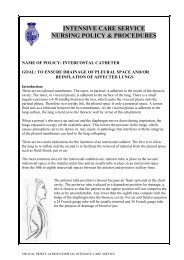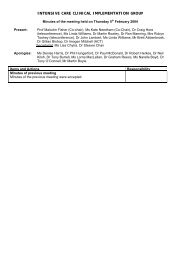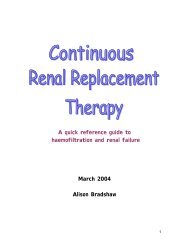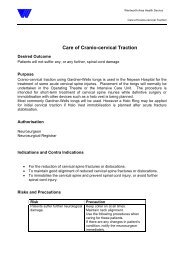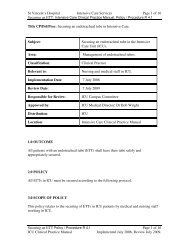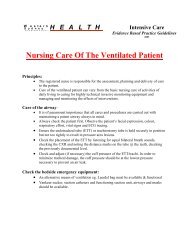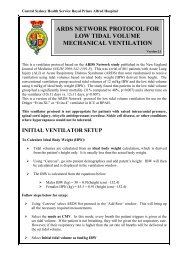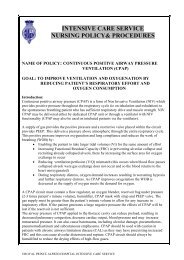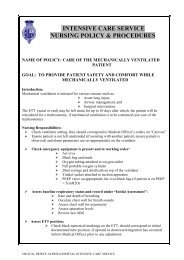thiopentone - Intensive Care & Coordination Monitoring Unit
thiopentone - Intensive Care & Coordination Monitoring Unit
thiopentone - Intensive Care & Coordination Monitoring Unit
Create successful ePaper yourself
Turn your PDF publications into a flip-book with our unique Google optimized e-Paper software.
Liverpool Health Service Drug Administration Protocol First Issued: December 2002<br />
<strong>Intensive</strong> <strong>Care</strong> <strong>Unit</strong><br />
(1 gram in 50mL sterile water, 20mg/mL) and highlighted to both medical and nursing staff.<br />
Clinical Considerations<br />
• Patients receiving <strong>thiopentone</strong> infusions are to receive vigilant attention to all aspects of infection<br />
control due to their increased susceptibility to opportunistic infection.<br />
• Patients receiving prolonged infusions should be nursed away from patients with MRSA and other<br />
infections that may be spread by droplet or hand contact.<br />
• Thiopentone does not have analgesic properties.<br />
• Daily serum levels are required to assess for a return of possible consciousness/responsiveness.<br />
A zero level is required before responsiveness is likely.<br />
• For patients receiving large doses of <strong>thiopentone</strong>, concomitant use of paracetamol must be<br />
regulated and liver enzymes assessed regularly.<br />
• Potassium levels are known to fall with <strong>thiopentone</strong> infusions. Replace to a low-normal value.<br />
• Use caution when weaning or ceasing infusions as rebound hyperkalaemia may result.<br />
• Always monitor potassium levels regularly during weaning and for 24 hours post cessation of<br />
drug therapy.<br />
References<br />
Carlton, J.B. 1997. The handbook of parenteral drug administration. (4<br />
th . Ed.). William’s Printers. Shepparton<br />
MIMS Online. CIAP: NSW Health Department. 1 May 2002 - 31 July 2002. http://www.mims.hcn.net.au/<br />
Krier, C. et al 1984 Hazards of high dose barbiturate therapy in head injured patients. Acta Anaesthesiolo gie Belgique. 35: 361<br />
– 365.<br />
Piatt, J. et al 1984 High dose barbiturate therapy in neurosurgery and intensive care. Neurosurgery. 15. (3): 427- 441.<br />
Megilli, C. 1985 Cerebral protection, pathophysiology and treatment of intracranial pressure. Chest. 87. (1): 85-93<br />
Mirr at al. 1983 Nursing management for barbiturate therapy in acute head injury. Heart and Lung. 12. (1): 52<br />
Stover, J.P. et al. 1998 Thiopental in CSF and serum correlates with prolonged loss of cortical activity. European Neurologique.<br />
39. (4):223-228.<br />
Nadal, P. et al. 1995 Pneumonia in ventilated head trauma patients: the role of thiopental therapy. European Journal of<br />
Emergency Medicine. 2.(1): 14-16.<br />
Roberts, I. Barbiturates in the management of severe brain injury. (Cochrane Review) In: The Cochrane Library, Issue 2.<br />
Oxford: Update Software; 1998. Updated quarterly.<br />
Schwab, S. et al. 1997 Barbiturate coma in severe h emispheric stroke: useful or obsolete? Neurology. 48. (6): 1608-1613<br />
Toyama, T. 2001 Anaesthesia and critical care: Barbiturate coma. http://www.trauma.org/anaesthesia/barbcoma.html<br />
Cairns, C., Thomas, B., Fletcher, S., Parr, M. and Finfer, S. 2002 Life threatening hyperkalaemia following therapeutic<br />
barbiturate come. <strong>Intensive</strong> <strong>Care</strong> Medicine 28:1357-1360.<br />
Policy Author(s)<br />
Policy Reviewers:<br />
M. Edgtton-Winn, ICU – CNC, and see “Pharmacology Acknowledgements.doc”<br />
ICU Director, ICU – CNC.<br />
Reviewed: September 2004 Authors: M. Edgtton-Winn Page 4 of 4<br />
Review Date: September 2005



